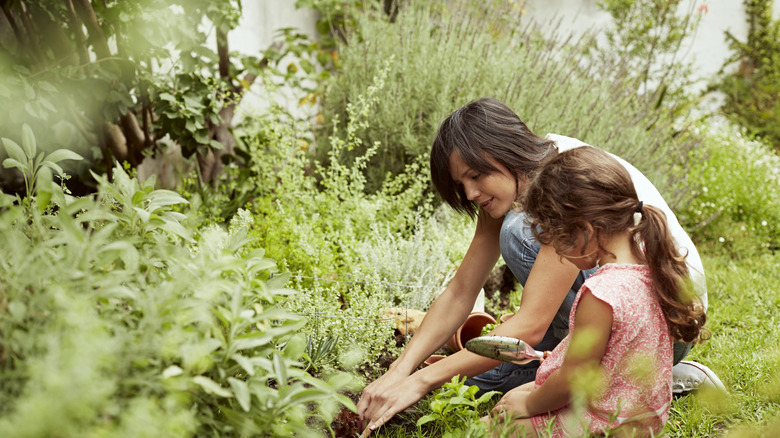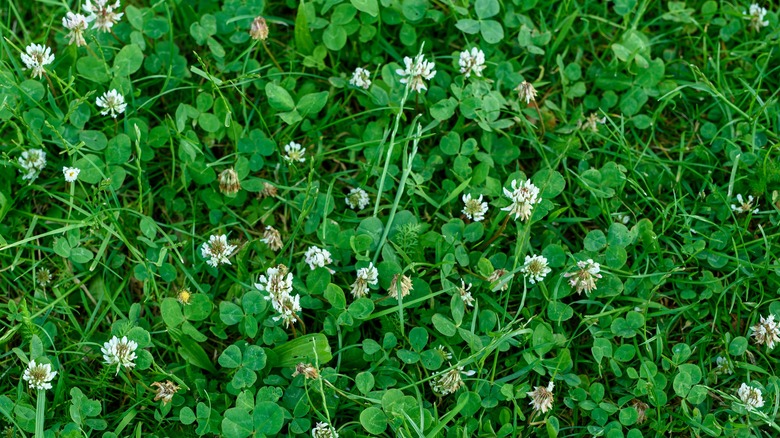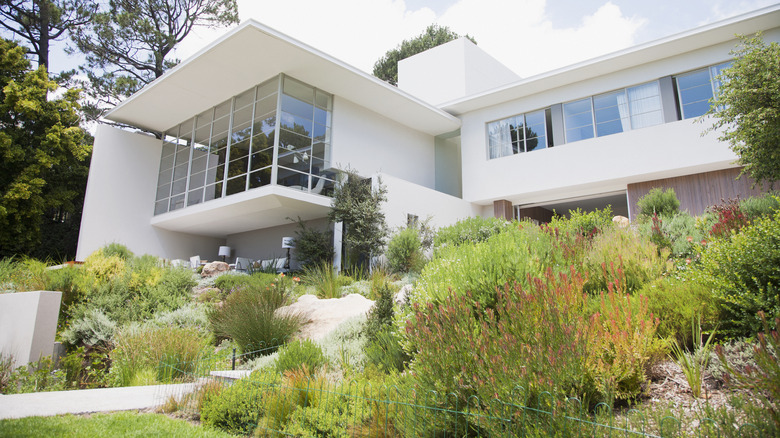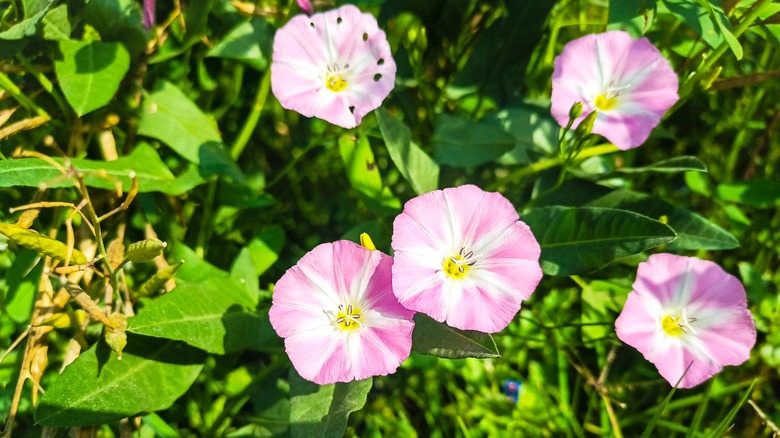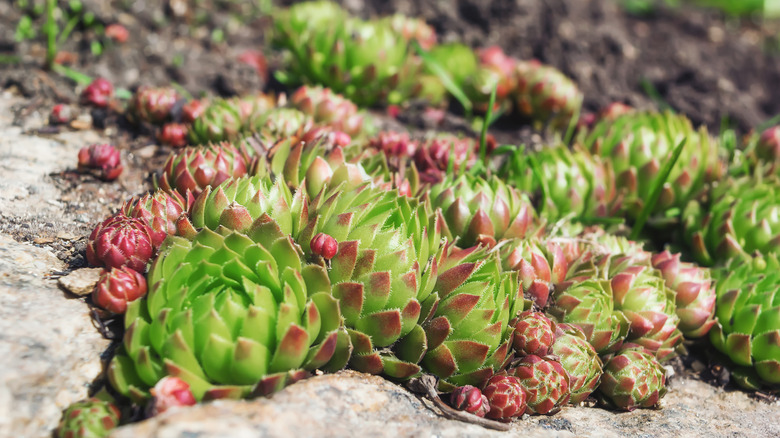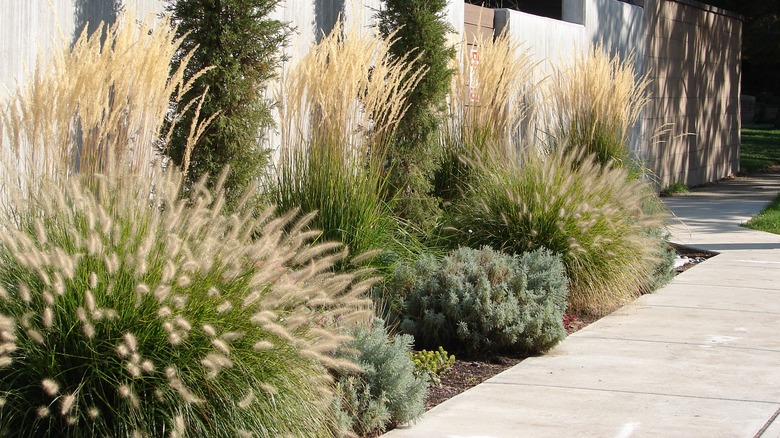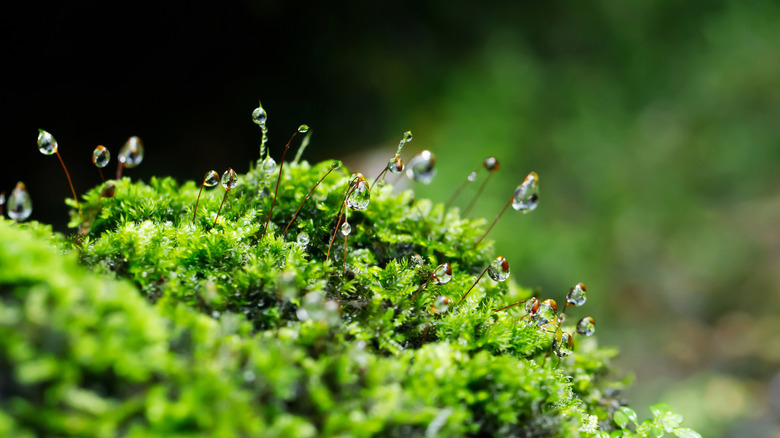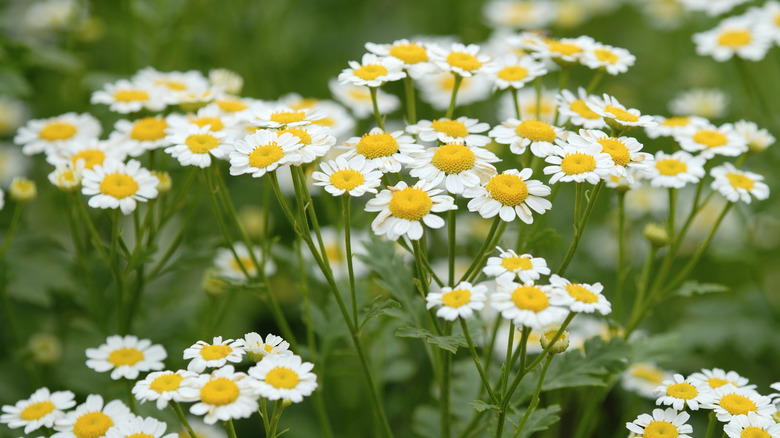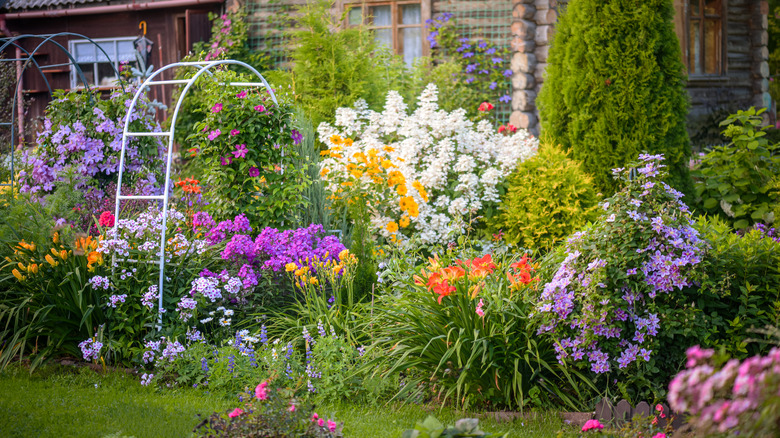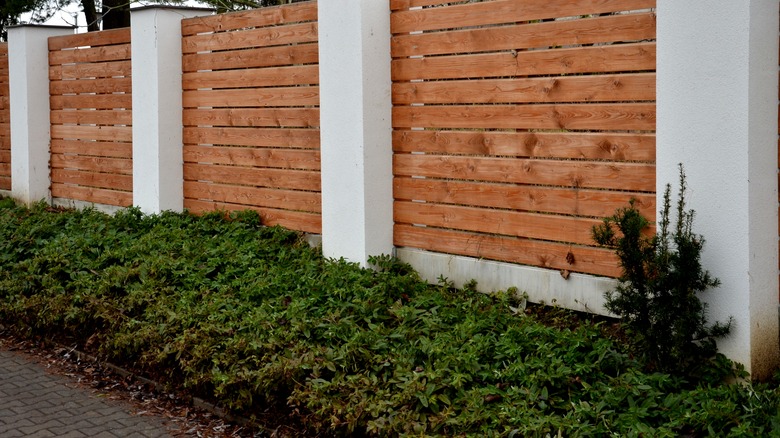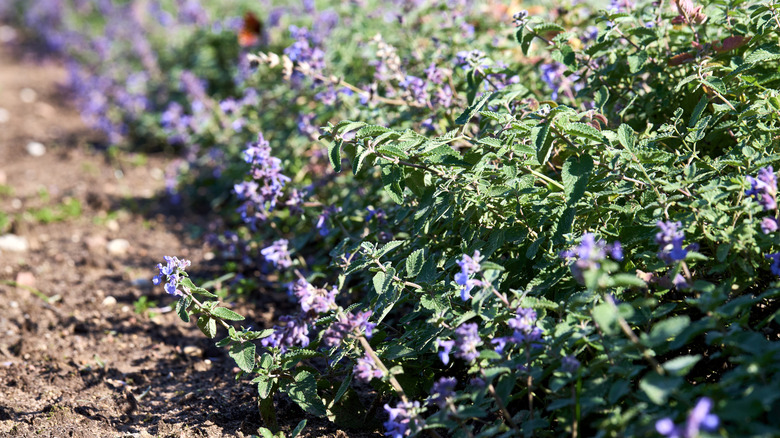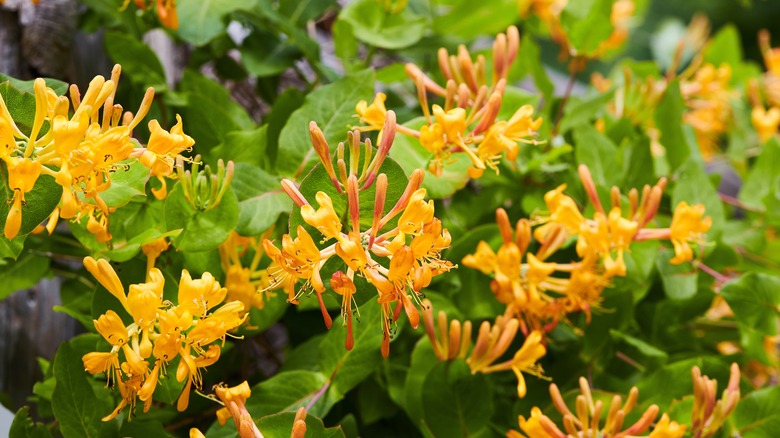These 11 Eco-Friendly Grass Alternatives Are A Friendly Option For Your Lawn
A good lawn can make or break a home, but it can also break the bank, and most importantly, the environment. According to the EPA, thirty percent of water usage in the US is devoted to outdoor use, amounting to almost nine billion gallons a day, and almost half of that water is wasted. No one wants an unsightly brown yard, and nixing the lawn entirely is out of the question. So how does one keep the lawn green while staying environmentally conscious? And is there a way to save money on water bills while doing so?
Social media sites such as TikTok have recently seen an influx of environmentally friendly lawn alternatives to the usual spread of grass. Not only are some of these options better for the planet and budget, but many of them offer an even more aesthetically pleasing bit of landscaping that will give your home a boost of curb appeal. Many of these options require significantly less upkeep than grass, and many offer much-needed elements for local fauna such as birds, butterflies, and bees. Get ready to say goodbye to the time, effort, and money that goes into mowing; there are options to explore no matter your climate and yard size to transform your lawn from grass to greatness.
Clover
There are a host of benefits to a clover lawn, and while significantly less watering is near the top, it may be one of its other obvious advantages of grass that causes you to make the switch. You don't need to use herbicides or pesticides with a white clover lawn, which is another step towards saving the environment. Clover is a win-all for climate, as it is drought-resistant and tolerant of both shade and sun. For dog lovers, this is another great grass replacement, since clover won't leave unsightly patches from pet urine.
You also don't have to totally get rid of grass when adding clover, as the two will peacefully co-exist. Clover will take over patches where your grass has failed to thrive, and will likely encourage more growth with the attraction of pollinating insects like bees and butterflies. There are several types of clover that will work in your lawn. White clover, red clover, and strawberry clover are all great choices for all seasons, but there are plenty of other clover stains to check out. You can most easily identify what's likely to thrive in your climate by seeing what clover occurs naturally in your area.
Native plants
Choosing to landscape your lawn with a host of native plants is the catch-all solution no matter your area and weather. If it grows naturally in your area, it's highly likely to thrive with little management on your end, since conditions will already be ideal for the foliage you select. Audubon provides an impressive list of reasons to go native with your landscaping such as low maintenance, combating climate change, water conservation, supporting local wildlife, and cutting back on pesticides that are harmful to humans and animals alike. Giving your lawn diversity with a host of different local plants also makes for an eye-catching and beautiful lawn that will stand out from the boring flat green of an all-grass lawn.
Most nurseries and home improvement stores unfortunately tend to offer up mostly non-native plants to the area. While it might seem like a chore to track down local plants, the temporary inconvenience is far outweighed by the pros of a native lawn. The National Wildlife Federation has a handy database of local host plants, specific down to your zip code. You can also seek out local plant nurseries, which has the added benefit of supporting local small businesses, or find books and online lists that can outline what local plants will work best in your area.
Creeping plants
While the name may be a little off-putting, it's got "creeping" in the name, the plant may just be the right ground cover for you. Spice up the usual green with points of colorful flowers when you use creeping plants such as creeping thyme, creeping jenny, creeping oregano, creeping charlie, creeping blue star, and countless other beautiful grass alternatives. For example, creeping thyme is drought resistant, doesn't require mowing, is perennial (so you don't have to re-plant it every year), chokes out weeds, attracts pollinators but repels many pests, has a pleasant smell, and you can walk on it. Like any plant, it may die out in high-traffic areas, which is where stone or gravel paths come into play.
For as many creeping plants as there are, there are as many varieties of each to work with. Creeping thyme has varieties like red creeping thyme, elfin thyme, English thyme, and wooly thyme. Choosing what creeping plant will work in your lawn will take time, research, work, and usually a fair bit of money, but once established is likely to thrive far more than any grass lawn would. According to Plant Natural Research Center, plants like creeping thyme are "hardy in US Hardiness Zones 4 to 10." Finding out what creeping plants are either native or work best in your area can be as simple as a quick internet search.
Hens and Chicks
If you're having a tough time getting anything to grow on your lawn, either due to a harsh climate or rocky soil, Hens and Chicks have you covered. In fact, they work best in sandy or gravely dirt that drains well, and also says that they don't need any fertilizer. While you probably wouldn't want to do a full lawn of succulents, as they can't really be walked on, this is a great alternative to fighting with a few patches of grass in an attempt to keep your lawn lively. Creating a rock garden dotted with these colorful and hardy plants is the perfect way to set your home apart from the rest without agonizing over hours of lawn care and a high water bill.
Hens and Chicks is a common name that is applied to many types of Sempervivums, so there are different types to suit different climates. In general, Hens and Chicks have a hardiness score of 5-10, which is very hardy. They love a lot of light and full sun, but there are some types that grow well in partial shade, too. Once they are mature, they require very little water, thriving on neglect. Even though they're great for hot weather, they are also incredibly cold-resistant as well, if you pick the right type. You can peruse each kind's tolerances against the USDA Plant Hardiness Zone Map.
Drought-resistant grasses
Whenever the word "grass" comes up, it tends to bring that trimmed, green lawn to mind. This isn't the same thing, though the mistake can be easy to make–Kentucky bluegrass is the most common type of lawn, but as for grasses, it is merely one out of 11,500 types worldwide. One such type of grass is mondo grass, also called dwarf lilyturf or monkey grass. It makes for amazing ground cover and grows year-round. Gardening Knowhow states that it thrives in almost any soil and lighting conditions and that it does not require much attention once it's been established.
Drought-resistant grasses can be divided into two categories; warm season and cold season. Overall, warm-season grasses tend to be more tolerant of dry climates, while cold-season grasses may need a little more water by comparison. Some drought-resistant grasses look amazing when you allow them to grow to full height, but most can be mowed down and still look wonderful if that's what you or your HOA wants. You can also find most types of grass bred specifically to be more tolerant to drought conditions, even the ever-popular bluegrass, but it is best to find a grass noninvasive to the area to support the local environment.
Moss lawns
If getting your lawn enough water isn't your problem, you may instead struggle with finding ways to keep it from drowning. This is where the moss lawn comes into play. Moss can tolerate a lot of water, but also thrives in most climates, with the exclusion of arid environments. It's also a great ground cover if you don't have the perfect flat lawn, as it will sprout up on hilly rises that tend to repel grass. You can walk on moss, though it doesn't stand up to heavy foot traffic, and it's a low-growing plant, so you don't have to worry about mowing it.
Moss doesn't need fertilizer or pesticides, and is generally left alone by animals, so you don't have to worry about wildlife munching on it. Once moss is established, it doesn't need constant watering and can bounce back from dry spells. However, moss doesn't do well with high sunlight exposure, and tends to work best in shade. It's also more delicate than grass. Moss can be a little tricky to get started, too, since it grows from spores instead of seeds. You will most likely have to buy flats of live moss and go from there. This vibrant green ground cover is worth the drawbacks, though, and if your lawn is rocky, uneven, or full of poor soil, it may just be the right choice for you.
Chamomile
Chamomile isn't just a tasty tea; it's also a plant — one that makes for great ground cover and a perfect grass alternative. For low foot-traffic areas, this plant makes a lovely and vibrant lawn that requires no mowing or edging. If the flowering variety is a little much for you, there's also the non-flowering dwarf cultivar, Treneague, which is rated for USDA hardiness zones 4-11.
Chamomile does best in sunny areas with light soil. Chamomile will spread out and close gaps quickly, so while it may cost you when you start out, you will find that you do not have to seed your entire yard by a long shot. Once it's established, there's not much you have to do to care for it; just let it thrive as it would in nature. Not only does this cut down on water use, it also improves the soil, and of course, you can use the flowering variety to brew your own tea considering you won't have to spray it down with toxic pesticides. Just be certain not to use herbicides on this lawn, not only to be environmentally friendly, but most especially if you plan to make anything edible from your chamomile. If any weeds do crop up, you will need to pull them by hand. Considering how little care this ground cover requires, it certainly seems a fair trade-off to have to do a little weeding every now and again.
Flower beds
In 2020, "Save The Bees" was established to, as they so aptly put it, save the bees. A huge part of this non-profit organization and movement is planting bee-friendly flowers to support this incredibly important insect. With that in mind, one of the most environmentally-friendly lawns you can have is one with plenty of flower beds. You can purchase budget-friendly flower mixes to help sustain the species of bees in your location, and your lawn will look incredible for it.
Flower beds can be used to fill up a lot of space that once belonged to grass. Or, you can take out grass entirely and add footpaths between your flower beds for a full enchanted garden feeling that will make everyone fall in love with your home. You can even sneak some fruit, vegetable, or herbs into your flower beds for an added touch of home-grown food so long as you are not using any pesticides or herbicides in your garden. If your home is new to you, you will want to find out if any chemicals have been used in the soil previously and research their lifetime and effect. It is possible you may want to avoid the soil already in place and turn to raised garden beds with new soil if chemicals have been used on your lawn previously; be thorough in your investigation, as some people may forget about previous pest control when thinking only of lawn treatments.
Shrub beds
Shrubbery is another great choice to spruce up your lawn and replace large areas of grass. Additionally, shrubs are thick enough to give your front lawn some much-needed privacy if you don't have any fences or trees to offer a little cover to your home. Not only can they make the exterior of your home look more put-together and inviting, but there's a shrub for every climate that will flourish with minimal maintenance.
As humans encroach further and further into wildlife habitats, it is imperative to the environment to give wildlife remaining in occupied areas a place to live. Shrubs are a great choice for avid birders and animal lovers, as some shrubs offer the perfect place to build a nest or great hunting grounds for bugs you would rather keep out of your home to begin with. If you don't want the tall growth of many flowering shrubs, there are also ground cover varieties; This Old House suggests dwarf summersweet in particular. Plant shrubs with gaps between as they will fill out more as they grow, and keep traffic in mind as you plant them. Keep your region and seasons in mind when picking your shrubbery, as some shrubs will look better year-round than others.
Bugleweed
Commonly known as bugleweed, Ajuga makes a great ground cover and eco-friendly alternative to grass. This plant goes by many different names, such as St. Lawrence plant, a few variations of "bugle," and a couple of "carpet" and "carpenter" names. While the "weed" part of the name may make you apprehensive at first, this plant isn't a weed in the way we think of; it is merely one which spreads and covers the area it's planted in. While this makes planting them over your lawn relatively easy, you must also take care to be sure the plant doesn't invade neighboring lawns. Bugleweed is similar to mint in that regard, and any experienced gardener can tell you that once mint is there, you'll have to fight to get it out. This makes bugleweed a great lawn, as it seems to thrive in any circumstances, but be certain there are borders to your lawn to keep it contained. If that's not enough to convince you of its stubborn desire to stay around, bugleweed does well in USDA hardiness zones 3-10.
When summer rolls around and the Ajuga plant blooms, it makes for an unforgettably beautiful lawn that stands out from the green ground cover that will remain the rest of the year. These flowers attract butterflies, which will make for an even more beautiful lawn, and support your local butterfly population.
Honeysuckle
If you grew up in a region with wild honeysuckle, you may fondly recall summers as a child picking these flowers to taste their nectar. What you may not have known is that it makes for great ground cover; an aromatic, vibrant alternative to grass. Honeysuckle has over 180 varieties, including creeping honeysuckle, so consider your options and look into which species will grow best in your area before you plant them.
Michigan Bulb cites Dropmore Scarlet Honeysuckle as a great option to grow over fencing to liven up your landscaping as well as good ground cover on slopes. Honeysuckle also grows on structures, so if you so desired, you could have several different colors all throughout your landscaping. Butterflies and hummingbirds especially are attracted to honeysuckle, and it blooms all through spring, summer, and late fall. It requires damp soil, but not wet, and works especially well in sunny areas. You don't need to mow it and it can be pruned to shape, and it only requires a little mulch in the wintertime to preserve the moisture of the soil it is growing in. For a colorful, fragrant, and easy-to-care-for lawn, honeysuckle makes the cut and more.
